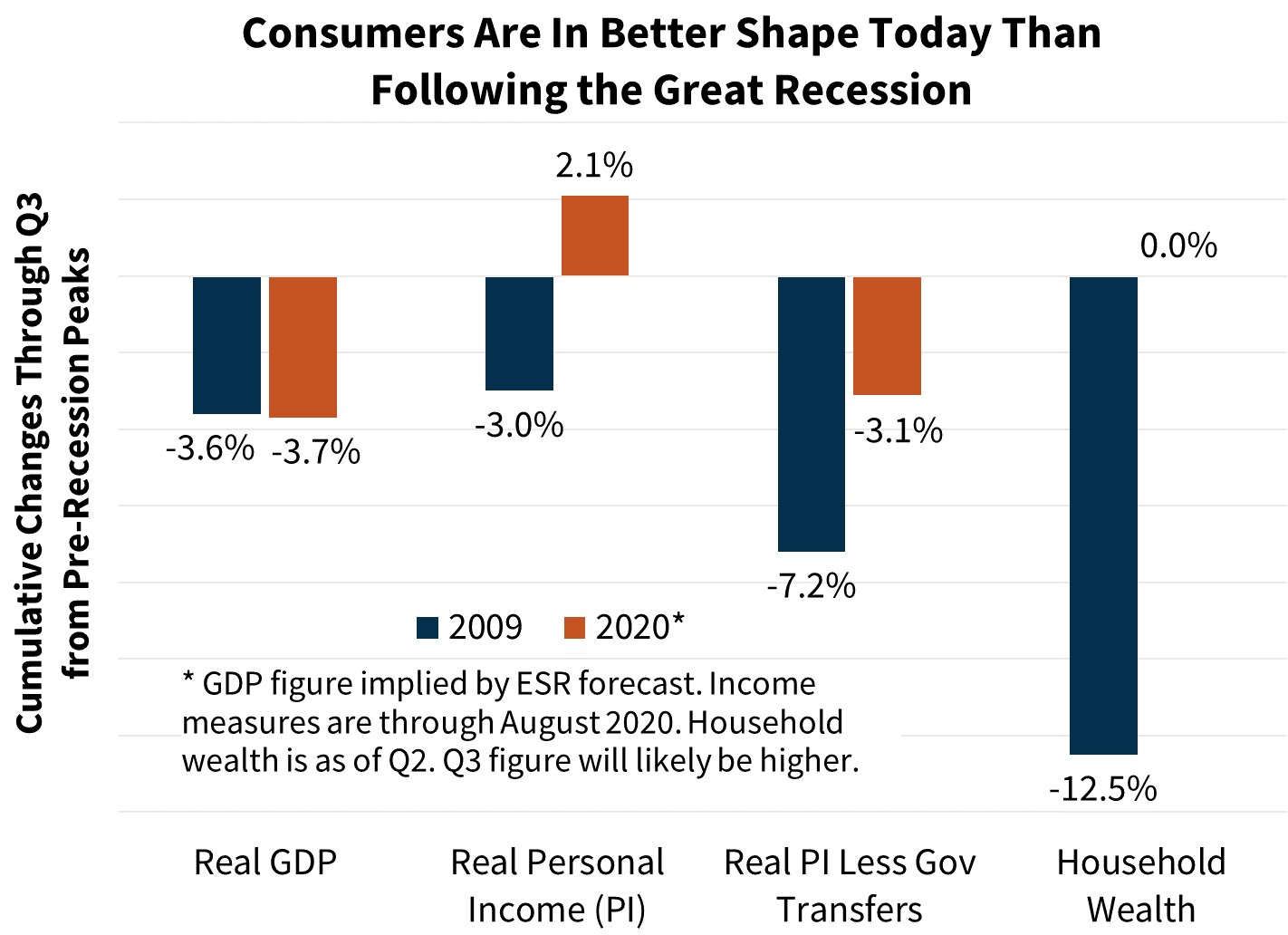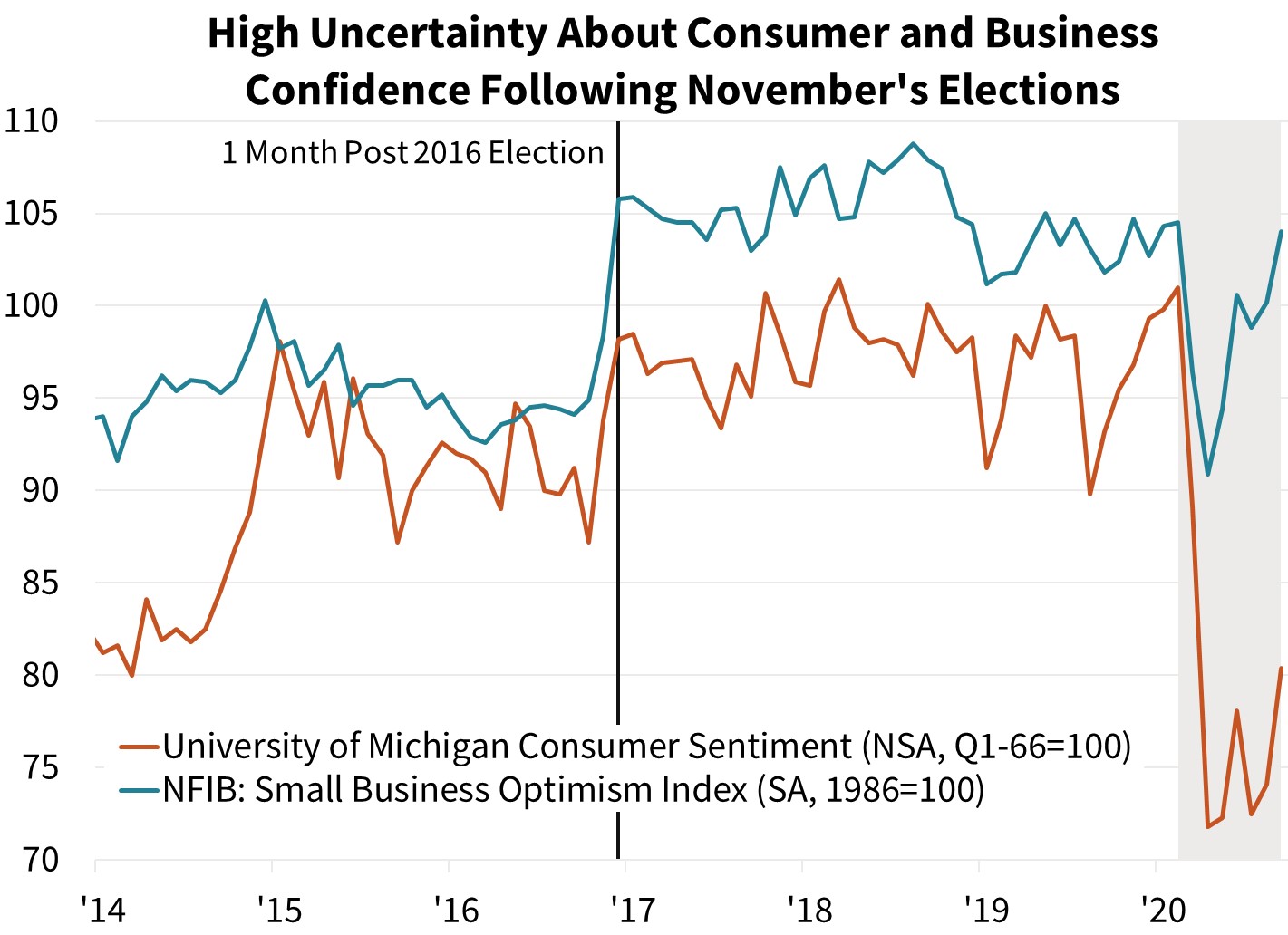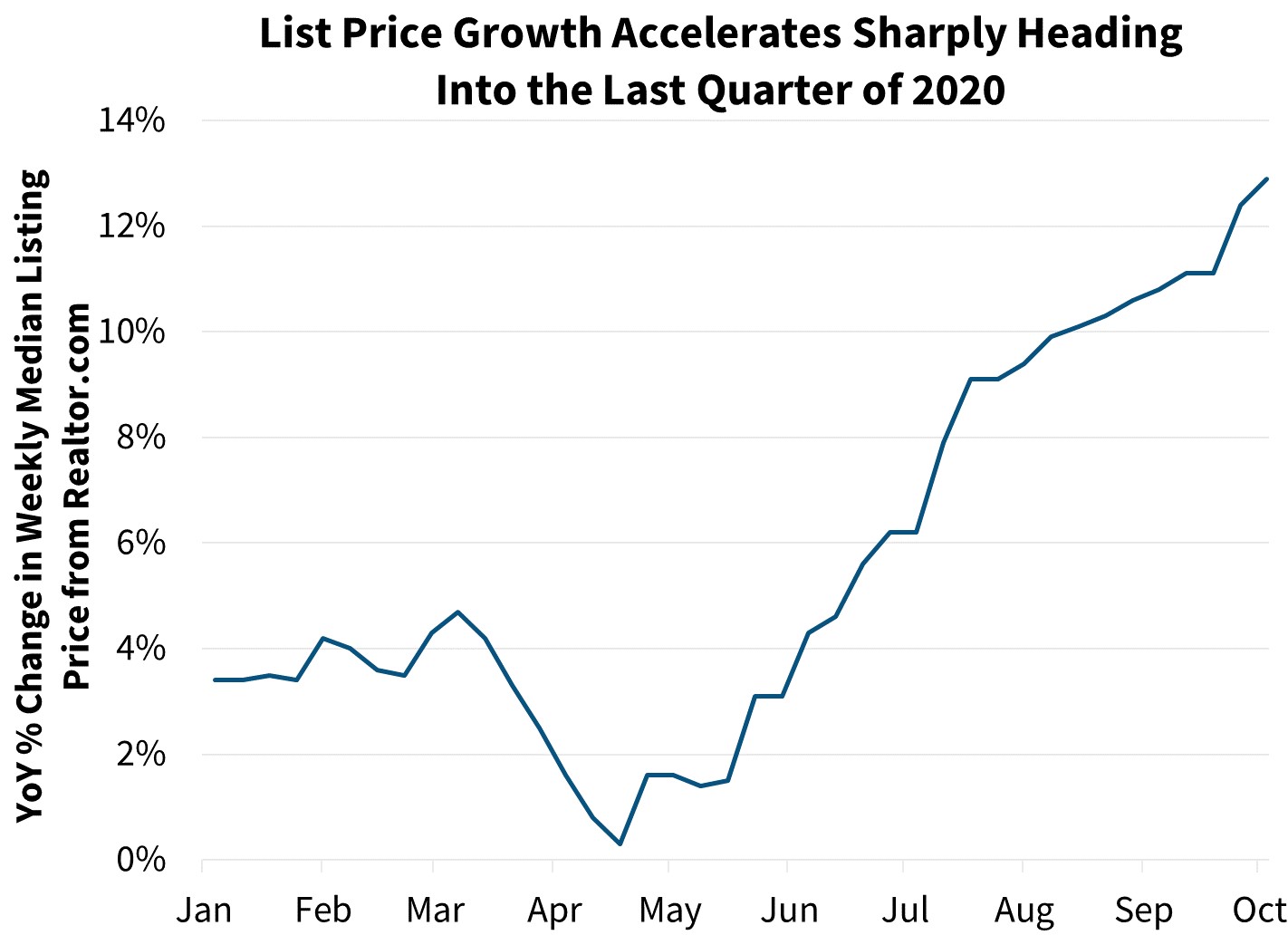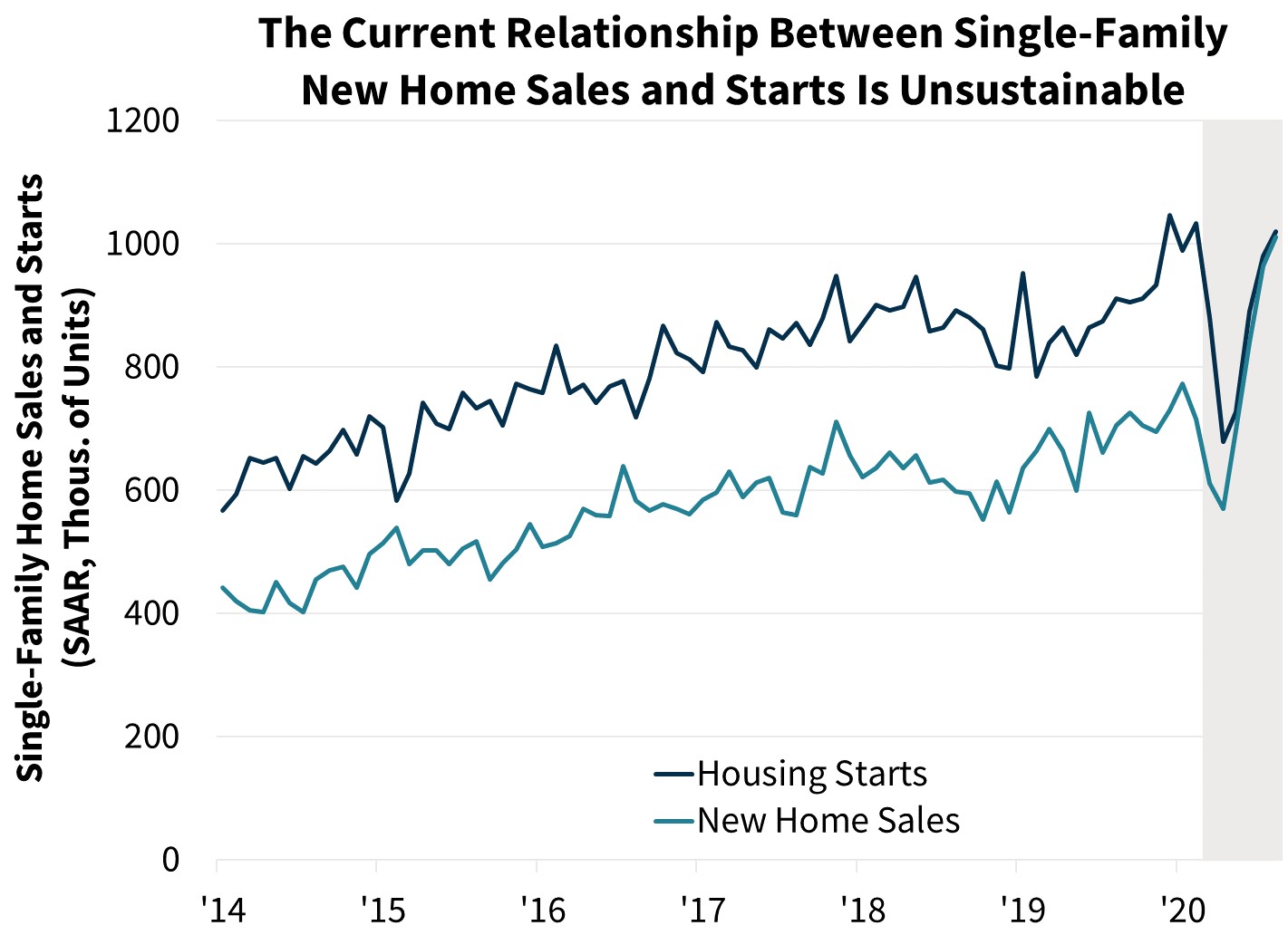Recovery Continues amid Heightened Uncertainty as Strong Housing Demand Faces Limited Supply
Despite the large decline in economic activity in the first half of the year, we continue to expect that the ongoing recovery will be sufficiently robust such that real gross domestic product (GDP) will only contract by 2.6 percent in 2020, before increasing by 3.5 percent in 2021. Risks to the forecast are unusually elevated given the ongoing pandemic and the November election.
Meanwhile, housing data continues to show strength, which led to an upgrade of our forecast for home sales, starts, and home prices for the remainder of the year. We now expect total home sales in 2020 to be 3.6 percent higher than in 2019 and residential fixed investment in the third quarter to have rebounded above pre-COVID levels. Given the housing outlook and robust refinance volumes, we increased our forecast for mortgage originations in 2020 from $3.9 trillion to $4.1 trillion. However, we continue to expect that supply constraints and diminishing, pent-up demand will lead to a pullback in sales activity in 2021.
Consumers Still Have Potential to Drive Further Recovery
We forecast personal consumption expenditures (PCE) growth to decelerate sharply in Q4, on a quarterly basis, but consumers have the potential for stronger spending levels once COVID-19 and related policy measures are no longer a drag. At this point in the recovery, households are in a stronger position than they were coming out of the Great Recession. Both this year and in 2009, real GDP troughed in the second quarter. After one quarter of recovery in 2009, real GDP was 3.6 percent below its prior peak. Our Q3 forecast for this year represents the first quarter of recovery and would imply a similar decline of 3.7 percent from the Q4 2019 peak. However, despite these comparable changes in GDP, household income trends differ greatly between these two periods. Real personal income in Q3 2009 was 3.0 percent lower than the quarterly pre-recession level. In contrast, as of August this year, real personal income was 2.1 percent higher than the pre-recession level. While much of the difference can be explained by the broader scope of unemployment benefits this time around, the majority of the difference is not directly due to government payments. Real personal income (not including transfer payments) was down 7.2 percent in Q3 2009, compared to 3.1 percent as of August 2020.

The odd nature of COVID-19-related shutdowns and social distancing continues to drive a historically large gap between consumption and income levels, as reflected by the savings rate remaining at an elevated 14.1 percent in August, even as the supplemental $600 per week unemployment benefits expired. Additionally, unlike in 2009, most current households do not need to de-lever in the wake of house price declines and associated wealth losses. In fact, after months of elevated cumulative savings and rising asset prices, households in the aggregate likely have a cushion to bolster consumption beyond what would normally be supported by current income levels. This was not the case following the Great Recession.
There are two notable implications from this comparative difference. First, the future path of consumption growth is more limited by COVID-19-related behavior than by household budget constraints. Second, an additional stimulus bill would likely boost near-term growth, but we expect the effects would be comparatively modest. While there are clearly distributional factors and the package composition matters, in the aggregate, households are currently declining to spend their marginal income. Therefore, it seems that the propensity to consume from additional transfers would be comparatively muted. This was the primary motivation for us making only modest changes to our near-term forecast in recent months, in respect to changing legislation expectations.
Fed Remains on Hold and Acknowledges Heightened Uncertainty
At the Federal Open Market Committee’s (FOMC) September meeting, the federal funds rate was left unchanged at the zero-lower bound and the asset purchase floors remained at $80 billion a month for Treasuries and $40 billion a month for mortgage-backed securities, as expected. While the FOMC reinforced its prior announcement that it “will aim to achieve inflation moderately above 2.0 percent for some time,” the time period over which inflation would be averaged was left unclear. Additionally, skepticism over this policy appeared to percolate the FOMC itself as, in the September Economic Projections, members’ median projections for inflation did not reach 2.0 percent until 2023. Minutes from the meeting revealed that some participants wished to tie forward guidance for the federal funds rate explicitly to inflation moving above the 2.0 percent target. The meeting minutes also showed that many members expect further fiscal stimulus in their economic outlooks and warn that if stimulus does not come to fruition that the pace of economic recovery could be slower than anticipated.
Economy Transitions from the Bounce-Back to More Gradual Improvement
Our final forecast for Q3 real GDP growth was revised upward to 31.6 percent annualized from 30.4 percent in last month’s forecast. Incoming data points towards PCE being modestly weaker than previously forecast, but this was more than offset by a recovery in business investment, which appears to have occurred sooner than previously anticipated. These two factors also led us to revise downward our Q4 forecast from 6.2 percent to 4.9 percent (annualized rates). However, when combined with the Bureau of Economic Analysis’ final estimate for Q2 GDP showing a slightly smaller downturn in the spring, we still expect full-year 2020 GDP to contract 2.6 percent, unchanged from our prior month’s forecast. Our expectation for GDP growth in 2021 was also little changed, up only one-tenth to 3.5 percent growth.
Real PCE expanded in August for the fourth consecutive month, rising 0.7 percent. This was slightly weaker than anticipated and July’s gain was revised downward, prompting us to lower our forecast for Q3 PCE growth to 37.7 percent annualized from 39.9 percent. However, this downgrade was more than offset by upward revisions to the investment components. Proxies for business equipment spending suggest that activity we expected to occur in Q4 was likely realized in Q3. Business fixed investment (BFI) is projected to grow 21.7 percent annualized in Q3, a significant upgrade from our prior expectation of 11.9 percent. Similarly, businesses appeared to end the inventory destocking phase earlier than anticipated, suggesting inventory investment was a stronger supporter of Q3 growth, though that was likely partially offset by related increases in imports.
Employment continued its recovery in September, with nonfarm payroll employment rising by 661,000 and the unemployment rate falling five-tenths to 7.9 percent. This pace of job growth would be considered strong normally but represented a significant deceleration from previous months when gains easily exceeded one million jobs. The deceleration was amplified by a boost in temporary Census workers in August and an unusual seasonal adjustment with regard to school hiring in September. Ultimately, though, the slower pace of job growth is consistent with a comparatively slower pace of economic recovery than what occurred earlier in the summer. We forecast the unemployment rate to average 7.2 percent in Q4.
Coming Months Could be Pivotal for Next Year’s Growth Outlook
Risks to the forecast remain elevated. While many consumers continue to have incomes capable of supporting a stronger recovery than in our base forecast, as of this writing, new COVID-19 cases in the U.S. have begun to turn upward again. Cases also continue to rise in Europe, where some distancing measures and travel restrictions are being reimplemented. The possibility of similar restrictions reoccurring in the U.S., either through policy or personal behavior, represents a meaningful downside risk to growth. On the other hand, considerable resources are being spent on vaccine development, and its eventual availability could remove many of the remaining hurdles to further economic recovery.
Uncertainty surrounding fiscal and other policy also remains high. The range of potential outcomes pending the makeup of Congress and the White House is wide. The possibility of an additional stimulus bill provides an upside risk to our forecast. As of this forecast, we conservatively assume no additional stimulus package this year, except for an extension of the broadened unemployment benefits for self-employed and contractors set to expire in January. In the longer run, a wide mix of policies on international trade, healthcare, education, energy, and taxes are possible, and the ultimate combination implemented is likely to have competing positive and negative effects on growth.

If the presidential election results are close, the possibility of a winner not being determined for an extended period relative to past practice would be an additional downside risk for consumer and business confidence and, therefore, near-term growth. A large shift in sentiment occurred following the 2016 election that was generally unanticipated at the time. It is not clear what will follow this year’s election.
Housing Strength Continues, But Sales Pullback Expected
Existing sales moved up in August for the third straight month, hitting 6.0 million annualized units, the fastest pace since 2006. Year to date, however, they remained 3.2 percent below the same period in 2019. August’s gain represented a sharp deceleration from the prior two months’ rapid increases; however, the sales pace was still 10.5 percent higher than a year prior. Near-term leading indicators, such as mortgage applications and our analysis of Google Trends data, all suggest that the sales pace will continue to move higher on a seasonally adjusted basis. Furthermore, pending sales, which lead existing-home closings by 30 to 45 days, rose 8.8 percent in August, suggesting that the month’s 6.0-million-unit sales pace will soon be eclipsed.
These indicators provided mixed signals on whether the bump up will be in September or October (our forecast implies October), but they aligned in suggesting strength in coming months. While we upwardly revised our forecast for sales through the remainder of the year, we continue to believe the current sales pace to be unsustainable due to supply constraints. The months’ supply of homes for sale fell to 3.0 in August, tying the lowest on record. New for-sale listings have shown some signs of improvement but remain substantially subdued relative to the growth in purchases. While in retrospect we were too preemptive in our prediction for a sales pullback, we continue to project a softening sales pace in the fourth quarter and heading into next year.

Tight supplies of homes for sale are putting upward pressure on home prices. The CoreLogic National House Price Index showed an acceleration in annual house price growth to 5.9 percent in August, up 0.8 percentage points from July. As of the first week of October, Realtor.com reported that the median list price for existing homes was up 12.9 percent from a year prior, an acceleration from a month ago. The continued increase in prices may eventually induce more existing owners to list their homes for sale. The Fannie Mae Home Purchase Sentiment Index® (HPSI) continued to show an increasing share of respondents reporting that it was a good time to sell in September. On the flip side, strong price appreciation is negating much of the affordability benefits from lower mortgage rates. Consistent with these trends, our quarterly house price forecast was upgraded considerably. House prices, as measured by the FHFA index, are now expected to grow 6.4 percent in 2020, up two percentage points from our previous forecast. Moving into 2021, we expect home price appreciation to decelerate significantly along with a pullback in the sales pace near the start of the year. However, given current momentum, we upgraded our 2021 home price growth forecast to 2.1 percent, compared to our prior forecast of 1.0 percent.

The lack of existing homes for sale continues to bolster demand for new homes. Both new single-family home sales and single-family starts exceeded 1.0 million annualized units in August. New sales rose 4.8 percent to the highest level since 2006 and single-family starts posted a gain of 4.1 percent. However, the availability of new homes for sale is increasingly facing a similar tightness to the existing homes market. The months’ supply of new homes for sale at the current sales pace fell to 3.3 in August, the lowest on record. When considering only homes already completed or under construction, the inventory ratio sat at an even lower 2.6 months, also a record low. Homebuilders have maintained sales to this point by drawing down existing inventories while also relying on sales of homes not yet started. We predict this will end soon. The ratio of sales to starts in recent years has averaged between 0.70 to 0.75, largely reflecting that a significant share of homes built were for existing landowners who did not intend to sell them. In contrast, the ratio in recent months has been near parity. We expect the relationship to converge back to more normal levels through an accelerated pace of construction and a pullback in the sales pace.
Multifamily starts pulled back nearly 23 percent in August to 395,000 annualized units following a jump of 36.6 percent in July. While this series is notoriously volatile, we believe there was a surge in projects started early this summer, reflecting those in the planning pipeline that had been delayed due to shutdowns in the spring. Given the length of the planning process for multifamily projects, additional “pent-up” starts are expected in the coming months. However, we expect that the underlying trend in multifamily construction will be weak over the foreseeable future relative to single-family construction. While suburban multifamily demand is expected to hold up better, we believe the shift of at least some renters out of large metro areas and into homeownership will weaken demand for new projects in many areas.
For more on multifamily market conditions please see the October 2020 Multifamily Market Commentary.
Mortgage Originations Revised Upwards
We upgraded our purchase mortgage origination forecast again this month, consistent with recent strength in acquisition and securitization data, as well as our upgraded housing and home price forecasts. We now expect purchase originations to grow by 13 percent in 2020 to $1.5 trillion, about $53 billion higher than last month’s forecast. We expect purchase volumes to grow a further 5 percent in 2021, as gradually decelerating home price growth begins to dampen demand.
Our forecast for 2020 refinance volumes also increased this month to $2.6 trillion, an upward revision of $161 billion from last month’s forecast. This revision was driven by continued strong mortgage application activity, as well as stronger-than-expected incoming acquisition and securitization volumes. The total expected origination volume of $4.1 trillion for 2020 would be the highest on record, surpassing an estimated $3.7 trillion from 2003.
We expect some of the 2020 refinance volume represents activity that has been pulled forward in time and, thus, downgraded our 2021 refinance forecast by $21 billion to $1.1 trillion. Despite the slight decrease, 2021 refinance volume is still expected to be higher than the average annual estimated refinance volume of $0.9 trillion observed over the period of 2010 to 2019. Elevated refinance volume is consistent with our view of ongoing low mortgage rates. In fact, at the current interest rate of 2.87 percent, we estimate that 66 percent of outstanding first-lien loan balances have at least a half-percentage point incentive to refinance.
We expect mortgage rates to continue to decline through the fourth quarter, with mortgage spreads compressing from the sharply widened spreads seen earlier this year. The primary spread (30-year mortgage rate minus the 10-year Treasury yield) ended September at 221 basis points, down significantly from 270 basis points at the end of April, but still higher than 2019’s average of 180 basis points.
Economic & Strategic Research (ESR) Group
October 12, 2020
For a snapshot of macroeconomic and housing data between the monthly forecasts, please read ESR’s Economic and Housing Weekly Notes.
Data sources for charts:University of Michigan, National Federation of Independent Business, Bureau of Economic Analysis, Fannie Mae ESR Group, Realtor.com, Census Bureau.
Opinions, analyses, estimates, forecasts and other views of Fannie Mae's Economic & Strategic Research (ESR) Group included in these materials should not be construed as indicating Fannie Mae's business prospects or expected results, are based on a number of assumptions, and are subject to change without notice. How this information affects Fannie Mae will depend on many factors. Although the ESR group bases its opinions, analyses, estimates, forecasts and other views on information it considers reliable, it does not guarantee that the information provided in these materials is accurate, current or suitable for any particular purpose. Changes in the assumptions or the information underlying these views could produce materially different results. The analyses, opinions, estimates, forecasts and other views published by the ESR group represent the views of that group as of the date indicated and do not necessarily represent the views of Fannie Mae or its management.
ESR Macroeconomic Forecast Team
- Doug Duncan, SVP and Chief Economist
- Mark Palim, VP and Deputy Chief Economist
- Eric Brescia, Economist
- Nick Embrey, Economist
- Rebecca Meeker, Financial Economist
- Richard Goyette, Business Analyst
